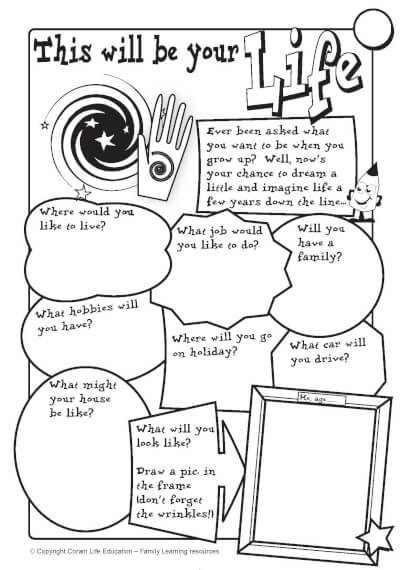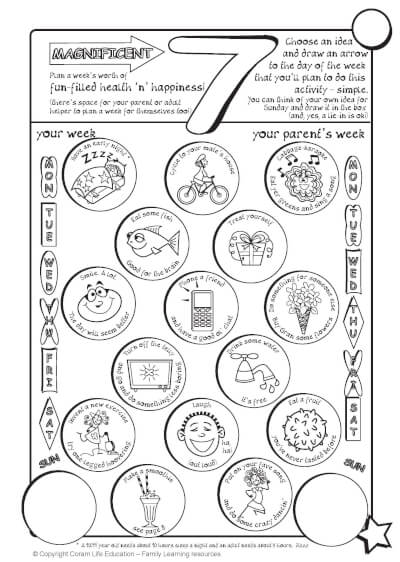Being my Best - 9 to 11 year-olds
What your child will be learning about…
- Developing a positive attitude to learning and building a growth mindset.
- Developing a wider range of strategies to help them bounce back when things go wrong.
- Different aspects of physical health - and how they can help themselves to keep healthy.
What your child can think about, or for you to talk about together…
Growth Mindset (for activities 1 and 2)
- What sort of things can you do now that you couldn’t when you were younger?
- Was it always easy to learn to do those things?
- What did you have to do in order to make it easier? (Keep practising, not give up, try to learn from mistakes, get ideas or help from other people etc.)
- What would you like to improve at now?
Keeping healthy (for activities 3 and 4)
- What different things can help you to keep healthy?
- How many different things can you think of?
- What can you do to keep yourself healthy?
What your child can do - together with you, or independently...
Activity 1 - Practice makes progress!
Start by thinking about things you're good at - your skills! Remember... most skills come from a person working hard at something, from practising it over and over again. If there's an adult at home who's not busy, talk about the things you're good at - you could even name each other's special skills.
People who are really good at sport, for example, have had to work hard to be that good! They've spent hours and hours sticking at something (practising and persevering). In fact perseverance and practice are probably more important than natural talent when it comes to being good at something!
Have a look at the picture of the Learning Line below. You may have seen this before at school and may remember it.
Now, think about something you found hard to learn, but eventually succeeded at! Use the Learning Line to remember the different stages you went through to finally succeed in the new skill.
Next, think about something you would like to get better at. It can be...
- A new skill that you've never tried before
- Something you already do but want to improve at
- Something very small or something bigger
You can start by thinking about breaking the new skill down into small steps. If you're feeling that you just can't do something, work through the questions on this special chart. It will help you to focus on what you CAN do, rather than what you CAN'T do!
You could create a progress chart or diary to record how things go each day. Remember to celebrate small successes! These are the stepping stones to bigger progress. Notice how long it takes to learn your new skill - some things take longer than others, but you'll get there in the end, if you keep trying!
Activity 2 - This will be your life!
Complete the This will be your Life activity sheet (below). If you don't have a printer, you can just write the different sections on a piece of paper.

Next, have a think about some of the skills you'll need to develop, to achieve your ambitions for the future! Remember - small, achievable tasks will help you to build your skills over time! Make a list of some of the steps that will help lead you to your goals!
Activity 3 - Healthy me!
We hear lots of things about how we can keep healthy. Most of these are quite simple, like doing about an hour of exercise (for children your age!) most days and eating plenty of fruit and veg, getting a good night's sleep! It's not rocket science!
If possible, print the sheet below and use it to set some healthy living targets for the week! If you don't have a printer you could draw your own pictures of different activities.

Activity 4 - Get active indoors!
If you're stuck at home it can sometimes be hard to do exercises!
Try these Indoor Activities to get your heart-rate up and build some fitness! Some of them need more than one person to do, but some can be done by yourself.SCARF values I thought about...
Which of the SCARF values did the activities include?
You can point to these, or if you're making a SCARF journal you can write them down and tick those you did. There's no right or wrong answer! It's up to you to decide!
Safety
Caring
Achievement
Resilience
Friendship
About SCARF at Home activities
Information for parents and carers before you start using the SCARF at Home activities
Your child's school is sharing some activities with you to help keep children happy and healthy while they're at home. The activities support children's PSHE (Personal, Social, Health and Economic) education and have been provided by the UK's largest children's charity specialising in children's health and wellbeing, Coram Life Education and SCARF.
Coram Life Education and SCARF help schools to teach children valuable life skills needed to keep them happy, healthy and safe.

